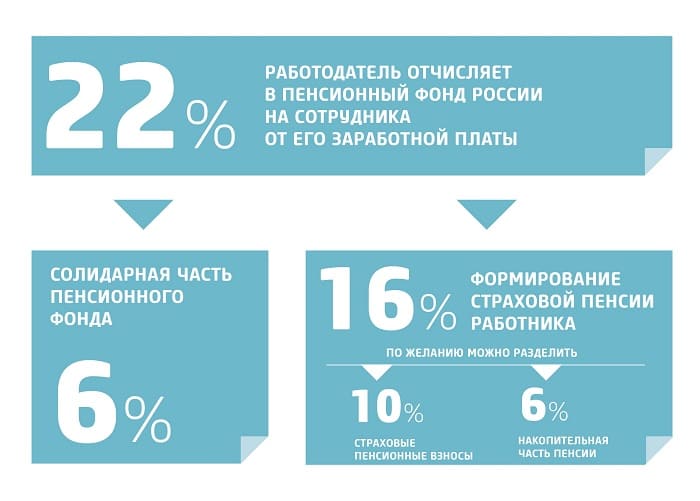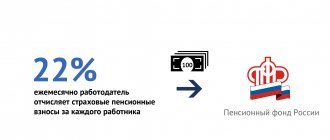Compulsory pension insurance is regulated by Federal Law No. 167 “0b compulsory pension insurance in the Russian Federation” dated December 15, 2001. The financial system is disclosed in detail in Chapter 4 of this law.
All funds managed by the Pension Fund are Federal property; moreover, they cannot be withdrawn and distributed for needs not related to the activities of the Pension Fund of the Russian Federation. The insurer (also known as the Pension Fund) forms its budget for the financial year, taking into account expenses and income. The government annually requests a full report on the execution of the Pension Fund budget. The OPS budget is consolidated, that is, it consists of a set of budgets of all levels, and also participates in forecasting and calculations.
What is a non-state pension fund?
Non-state pension funds (NPFs) help save money for a dignified old age. You or your employer contributes to them, and the funds invest these funds so that they do not depreciate over time. When you retire, these savings begin to gradually pay you in the form of a pension.
NPF can help you increase your pension in two ways:
Increase the funded part of the state pension
From 2002 to 2013, part of employers’ mandatory pension contributions went not to the general account of the Pension Fund of Russia (PFR), but to the individual pension accounts of employees. These amounts can be left there, in the Pension Fund (they will still remain personal), or they can be transferred to one of the non-state pension funds. These individual accounts can be replenished independently - then the state pension will be larger. You can read more about this in the article about the role of non-state pension funds in compulsory pension insurance (OPI).
Create an additional pension
The second option is also possible: choose a non-state pension fund and enter into a non-state pension provision (NPO) agreement with it. This will allow you to organize a second, additional pension. This is the option Vasily chose.
Many funds simultaneously deal with state and supplementary pensions. If you transferred your pension savings to a non-state pension fund and are satisfied with the way it manages your funds, then you can start saving money there for an additional pension. But for this, the fund will enter into a separate agreement with you and open another account for you. If desired, you can enter into an agreement with another fund.
How are the funds spent?
All expenses incurred by the Pension Fund of the Russian Federation as a result of performing the functions assigned to it are carried out at the expense of the federal budget and participate in the general calculation of Pension Fund expenses for the financial year.
The funds are spent on:
- payment of insurance coverage under compulsory insurance;
- delivery of pensions;
- logistical support for the activities of the insurer;
- payment of contributions to the pension savings guarantee fund;
- other goals that do not contradict the pension legislation of the Russian Federation.
Structure of pension fund expenses.
All expenses that were not provided for by the budget of the Pension Fund of the Russian Federation when drawing up the plan for the current year can only be incurred if they are approved in the manner prescribed by federal legislation.
Compensation for that part of budget expenses that exceeds the amount of funds received from paying contributions occurs through budgetary allocations.
All OPS funds are accounted for in accounts accessible to territorial bodies of the Federal Treasury in the divisions of the Central Bank of the Russian Federation. This is done to monitor all operations carried out with funds from the budget of the Pension Fund of the Russian Federation.
How are these ways to boost your pension different?
You can decide for yourself what suits you best - choose just one way to increase your pension, or both: save for both the state pension and the supplementary pension. But it is worth considering that each option has pros and cons.
- NPF in OPS
- NPF in NGO
– Moderate returns Funds can invest only in the most reliable financial instruments.
+ Savings are insured Pension savings in the compulsory pension system are insured by the state. Whatever happens to the fund, the entire amount of contributions made will be returned to your individual pension account at the Pension Fund.
– Strict rules Standard rules for contributions and payments, assignments and indexation of pensions are established by law. For example, if you top up your account through your employer, you need to indicate in advance a specific amount or percentage of your salary in the application. If you want to receive the funded part of your pension not for life, but for some period of time, then it must be at least 10 years.
+ Profitability may be higher. Non-state pension funds may choose slightly riskier, but in the future, more profitable assets.
– Investments are not insured Voluntary contributions are not included in the deposit insurance system. If the fund fails, there is no guarantee that you will get your savings back.
+ Flexible conditions When you save for retirement on your own, you determine the convenient amount and frequency of contributions and payments, the rules for transferring savings by inheritance and other conditions.
Vasily wants to have more income in his old age and is not afraid to take risks, so he decided to save for an additional non-state pension.
Now the main thing for Vasily is to choose a reliable NPF that can profitably invest his money.
Choice options: NPF or management company
You can dispose of your funded pension in three ways: do nothing, choose a non-state pension fund, or deliberately choose the Pension Fund of Russia as the insurer, and then the management company from its register.
If you don’t choose an insurer, the Pension Fund becomes it, and you are called silent. The Pension Fund sends your money to the management company Vnesheconombank - VEB. It was her who was appointed by the state to manage the money of the silent ones. VEB Management Company invests your savings, reports to the Pension Fund, and the Pension Fund to you.
If you choose a non-state pension fund, your money will go to several management companies that this NPF will choose. They won't let you choose.
If you deliberately choose the Pension Fund of Russia as your insurer, it will ask you which management company from the list to send the money to. You cannot divide pension money between several management companies; you can choose only one, and do it yourself - there is no “default” option here.
How to choose a non-state pension fund with high yield?

The Bank of Russia clearly regulates what non-state pension funds can invest their clients’ funds in (high-risk instruments are excluded), and strictly monitors compliance with these requirements. However, any investment carries risk. And the higher the probable return, the higher the risk usually is.
Before concluding an additional pension agreement with a fund, it makes sense to study its investment declaration to understand what exactly it plans to invest the money you entrust to it. NPFs are not required to disclose it, but may do so.
Much depends on the professionalism of the experts who manage NPF money. If for several years the return on investment of a particular non-state pension fund is above the market average, then most likely it has a strong team of investment specialists.
You can compare the return on investments of different funds in summary tables on the Bank of Russia website. If the fund operates in both the compulsory pension insurance system and the non-state pension system, then the profitability indicators for these two areas are published separately, and they may differ. Therefore, first, choose what type of fund investment you are interested in and check the profitability over several years.
On the regulator’s website, funds show their total investment income before deducting their own commissions and other payments. The net profitability that NPFs accrue to client accounts can now only be viewed on the websites of the NPFs themselves.
It is also worth remembering that past performance is not a guarantee of the same profitability in the future. Moreover, first of all, when choosing a non-state pension fund, you should still think about its reliability, and only then about profitability.
Pension provision
There are three types of pension provision in the Russian Federation:
State pension provision based on financing pensions from the federal budget. State pension benefits are assigned to civil servants (including military personnel, employees of law enforcement agencies, as well as members of their families), participants in the Great Patriotic War, citizens awarded the “Resident of Siege Leningrad” badge, citizens affected by radiation or man-made disasters, and members of their families, cosmonauts and members of their families, flight test personnel, as well as socially vulnerable citizens who, due to circumstances, have not acquired the right to an insurance pension - disabled citizens.
Compulsory pension insurance, which includes an insurance pension and is financed by employer insurance contributions. Citizens of the Russian Federation who are insured in accordance with Federal Law dated December 15, 2001 No. 167-FZ “On Compulsory Pension Insurance” and disabled family members of insured persons in the event of loss of a breadwinner have the right to an insurance pension. Foreign citizens and stateless persons permanently residing in the Russian Federation have the right to a labor pension on an equal basis with Russian citizens, unless otherwise provided by an international treaty. Non-state (additional) pension provision – non-state pensions paid under agreements with non-state pension funds, financed by contributions from employers and employees in their favor and income received from their investment.
BASIC CONCEPTS Insurance pension is a monthly cash payment in order to compensate insured persons for wages and other payments and remunerations lost by them due to the onset of incapacity due to old age or disability, and for disabled family members of insured persons for wages and other payments and remunerations of the breadwinner lost in connection with the death of these insured persons, the right to which is determined in accordance with the conditions and standards established by Federal Law No. 400-FZ of December 28, 2013. At the same time, the onset of disability and loss of wages and other payments and remuneration in such cases are assumed and do not require proof.
Insurance experience is the total duration of periods of work and (or) other activities for which insurance contributions to the Pension Fund of the Russian Federation were calculated and paid, as well as other periods counted towards the insurance period, taken into account when determining the right to an insurance pension and its amount.
Individual pension coefficient is a parameter that reflects in relative units the pension rights of the insured person to an insurance pension, formed taking into account the insurance contributions for the insurance pension accrued and paid to the Pension Fund of the Russian Federation, intended for its financing, the duration of the insurance period, as well as refusal for a certain period from receiving an insurance pension.
The cost of the pension coefficient is a cost parameter taken into account when determining the size of the insurance pension, reflecting the ratio of the amount of insurance contributions for the financial support of insurance pensions and federal budget transfers received by the budget of the Pension Fund of the Russian Federation in the corresponding year, and the total amount of individual pension coefficients of insurance pension recipients.
A fixed payment to an insurance pension is provision for persons entitled to an insurance pension in accordance with Federal Law No. 400-FZ of December 28, 2013, established in the form of a payment in a fixed amount to an insurance pension.
Adjustment of the size of the insurance pension - an increase in the size of the insurance pension due to an increase in the cost of the pension coefficient.
Funded pension is a monthly cash payment in order to compensate insured persons for wages and other payments and remunerations lost due to disability due to old age, calculated on the basis of the amount of pension savings accounted for in a special part of the individual personal account of the insured person or in a pension account funded pension of the insured person, as of the day of assignment of the funded pension.
Pension savings funds - the totality of funds accounted for in a special part of the individual personal account of the insured person or in the pension account of the funded pension of the insured person, formed from received insurance contributions to finance the funded pension, as well as the result of their investment, additional insurance contributions for the funded pension, contributions employer paid in favor of the insured person, contributions for co-financing the formation of pension savings, as well as the result of their investment and funds (part of the funds) of maternal (family) capital aimed at the formation of a funded pension, as well as the result of their investment.
The expected period of payment of a funded pension is an indicator calculated on the basis of data from the federal executive body that carries out the functions of generating official statistical information on social, economic, demographic, environmental and other social processes in the Russian Federation, and used to determine the size of a funded pension.
Recalculation of the amount of the insurance pension is a change in the amount of the insurance pension that occurs without submitting a written application to the territorial bodies of the Pension Fund, due to an increase in the value of the individual pension coefficient for periods after 01/01/2015 according to individual (personalized) accounting in the compulsory pension insurance system. Recipients of old-age, disability and survivors' insurance pensions are entitled to an undeclared recalculation of the amount of the insurance pension. Recalculation of old-age and disability insurance pensions is carried out from August 1 of each year based on the amount of insurance contributions to the insurance pension that were not taken into account when determining the amount of the pension when assigning or recalculating. The amount of the survivor's insurance pension is subject to recalculation from August 1 of the year, following the year in which this pension was assigned. Declaratory recalculation of the pension amount is a change in the pension amount according to the documents submitted by the applicant.
Valorization is a monetary revaluation of the pension rights of all Russians with work experience before 2002. From January 1, 2010, the estimated pension capital formed before 2002 increases by 10% and an additional 1% for each year of a citizen’s work experience before 1991. To determine the percentage increase in pension capital for periods before January 1, 1991, the length of service that the citizen had on that date, taken into account when assessing pension rights, is taken into account. At the same time, there are no restrictions in this case; all length of service is taken into account, including beyond the maximum indicators (40 years for women and 45 years for men).
Payment of pensions is a monthly transfer by the territorial body of the Pension Fund of the Russian Federation of pension amounts accrued for delivery to the account of organizations delivering pensions to pensioners. Payment of accrued pension amounts is made for the current calendar month. Payment of pensions, including to working pensioners, is made by the territorial body of the Pension Fund of the Russian Federation at the place of residence or place of stay of the pensioner in the established amount without any restrictions. A pensioner living in a state or municipal stationary social service institution is paid a pension by the territorial body of the Pension Fund of the Russian Federation at the location of this institution.
Disability groups - depending on the degree of disability resulting from diseases, consequences of injuries or defects, a citizen recognized as disabled is assigned disability group I, II or III, and a citizen under the age of 18 is assigned the category “disabled child”. Disability of group I is established for two years, groups II and III – for one year. The category “disabled child” is established for one or two years or until the citizen reaches the age of 18.
Delivery of a pension is the transfer of the accrued pension amount to the recipient by handing it over at the cash desk of the delivery organization, or at home, or by crediting the pension amount to the pensioner’s account at a credit institution. Delivery of the pension is carried out at the request of the pensioner by a postal service organization, credit or other organization engaged in the delivery of pensions, with which the Pension Fund of the Russian Federation has concluded relevant agreements. The pensioner has the right to choose, at his own discretion, the organization that delivers the pension and notify the territorial body of the Pension Fund of the Russian Federation in writing.
A disabled person is a person whose ability to function in society is limited due to his physical, mental, sensory or mental impairment, which entails recognition of disability.
Adjustment – an increase in the size of the insurance pension due to an increase in the cost of the pension coefficient. The cost of the pension coefficient is determined by the Government of the Russian Federation.
Indexation of the fixed payment to the insurance pension - an annual increase in the fixed payment to the insurance pension from February 1 by the consumer price growth index for the past year and from April 1 an additional increase in the specified payment taking into account the growth in the income of the Pension Fund.
Conversion of pension rights is the transformation of pension rights acquired by citizens as of January 1, 2002 (at the beginning of the pension reform) into the amount of estimated pension capital. Its value is the equivalent of the amount of insurance contributions paid to the Pension Fund of the Russian Federation before January 1, 2002. This amount is determined by counting back the amount of the pension conditionally due to all insured persons as if they had reached retirement age by the specified date. For pensioners, as of December 31, 2001, not a conditional, but a real pension was established in the most favorable amount for them according to the pension legislation in force before the start of the reform.
Non-insurance periods taken into account in the length of service - along with periods of work and (or) other activities when insurance contributions were paid for a citizen to the Pension Fund of the Russian Federation, some non-insurance periods are also counted in the insurance period. These include:
- the period of military service and other equivalent service (for example, service in internal affairs bodies and other law enforcement agencies, service in the prosecutor’s office, etc.)
- the period of receiving compulsory social insurance benefits during the period of temporary disability;
- the period of care of one of the parents for each child until he reaches the age of one and a half years, but not more than six years in total;
- period of receiving unemployment benefits;
- the period of detention of persons unjustifiably prosecuted, unjustifiably repressed and subsequently rehabilitated, and the period of serving their sentences in places of imprisonment and exile;
- the period of care provided by an able-bodied person for a group I disabled person, a disabled child or a person who has reached the age of 80 years;
- the period of residence of spouses of military personnel serving under contract with their spouses in areas where they could not work due to lack of employment opportunities, but not more than five years in total;
- period of residence abroad of spouses of employees sent to diplomatic missions and consular offices of the Russian Federation, permanent missions of the Russian Federation to international organizations, trade missions of the Russian Federation in foreign countries, representative offices of federal executive authorities, state bodies under federal executive authorities or as representatives of these bodies abroad, as well as to representative offices of state institutions of the Russian Federation (state bodies and state institutions of the USSR) abroad and international organizations, the list of which is approved by the Government of the Russian Federation, but not more than five years in total;
- participation in paid public works and moving in the direction of the state employment service to another area for employment;
- the period counted towards the insurance period in accordance with the Federal Law of August 12, 1995 N 144-FZ “On Operational Investigative Activities”;
- the period of exercise of powers by a judge in accordance with the Law of the Russian Federation of June 26, 1992 No. 3132-1 “On the status of judges in the Russian Federation.”
All listed non-insurance periods are counted into the insurance period only if they were preceded or followed by periods of work for which insurance premiums were accrued (paid) to the Pension Fund of the Russian Federation. If several periods included in the insurance period coincide in time, only one of them will be taken into account when assigning a pension, at the choice of the citizen who applied for the pension. When calculating the insurance period in order to determine the right to an insurance pension, periods of work and (or) other activities that took place before the entry into force of Federal Law No. 400-FZ dated December 28, 2013 and were counted towards the length of service when assigning a pension in accordance with the law , in force during the period of performance of work (activity), may be included in the specified length of service using the rules for calculating the relevant length of service provided for by the specified legislation (including taking into account the preferential procedure for calculating length of service), at the choice of the insured person.
The expected period of pension payment is an indicator used to determine the size of the insurance part of an old-age labor pension (labor disability pension and labor pension in case of loss of a breadwinner) according to the norms of Federal Law No. 173-FZ. When determining the size of the insurance part of the labor pension, starting from January 1, 2013, the expected period of payment of the insurance part of the old-age labor pension on a general basis (labor disability pension and labor pension for the loss of a breadwinner) is set at 19 years (228 months).
State pension is a monthly state cash payment that is provided to citizens in order to compensate them for earnings (income) lost due to termination of public service upon reaching the length of service established by law upon retirement from an old-age (disability) insurance pension; or in order to compensate for the lost earnings of a citizen from among the cosmonauts or from among the flight test personnel in connection with retirement for long service; or for the purpose of compensation for harm caused to the health of citizens during military service, as a result of radiation or man-made disasters, in the event of disability or loss of a breadwinner, upon reaching a certain age; or disabled citizens in order to provide them with a means of subsistence.
State pension benefits are paid from the Federal budget and are of the following types:
- for length of service - appointed to federal civil servants, military personnel, astronauts and flight test personnel;
- for old age – prescribed to victims of radiation or man-made disasters;
- for disability – assigned to military personnel, WWII participants, persons awarded the “Resident of Besieged Leningrad” badge, citizens affected by radiation or man-made disasters, cosmonauts;
- in the event of the loss of a breadwinner - assigned to family members of military personnel, citizens affected by radiation or man-made disasters, and astronauts.
- social disability pension (assigned to disabled people of groups I, II, III, including disabled people since childhood, disabled children); social pension in case of loss of a breadwinner (assigned to children under 18 years of age and older, but not more than 23 years of age, full-time students form for basic educational programs in organizations carrying out educational activities, until they complete such training, but no longer than until they reach the age of 23 years, who have lost one or both parents, and children of a deceased single mother); social old-age pension (assigned to citizens from among the indigenous peoples of the North, permanently residing in areas inhabited by indigenous peoples of the North on the day of pension assignment, who have reached the ages of 55 and 50 years (men and women, respectively), as well as citizens of the Russian Federation who have reached the ages of 70 and 65 years (men and women, respectively), and foreign citizens and stateless persons who have permanently resided in the territory of the Russian Federation for at least 15 years and have reached the age of 70 and 65 years (men and women, respectively);
- social pension for children. Both parents of which are unknown (assigned to children under the age of 18, as well as over this age, studying full-time in basic educational programs in organizations engaged in educational activities, until they complete such training, but no longer than until they reach the age of 23 , both parents of which are unknown.
Estimated pension capital (RPC) is a calculated value, taking into account which the size of the insurance part of the labor pension is determined, including pension rights in monetary terms acquired by the insured person as of January 1, 2002, as well as the amount of insurance contributions and other income in Pension Fund for the insured person after the specified date until 01/01/2015. In this case, based on the insurance part of the labor pension, the value of the IPC for the period until 01/01/2015 is determined.
Experience is one of the most important factors influencing the right and amount of pension provision for citizens. There are insurance and general work experience.
Insurance length of service is the total duration of periods of work and (or) other activities taken into account when determining the right to an insurance pension, during which insurance contributions were accrued (paid) to the Pension Fund of the Russian Federation (PFR), as well as other periods counted in the insurance period.
Total length of service is the total duration of labor and other socially useful activities before January 1, 2002, taken into account when assessing the pension rights of citizens as of January 1, 2002. The total work experience includes:
- work as a worker, employee (including abroad), member of a collective farm or other cooperative organization; other work in which the employee was subject to compulsory pension insurance; work (service) in paramilitary security, special communications agencies or in a mine rescue unit; periods of individual labor activity (including in agriculture);
- creative activity of members of creative unions - writers, artists, composers, filmmakers, theater workers, as well as writers and artists who are not members of the relevant creative unions;
- temporary disability that began during the period of work and being on disability of groups I and II due to an injury at work or an occupational disease;
- staying in places of detention beyond the period prescribed during the review of the case;
- military service;
- receiving unemployment benefits, participating in paid public works, moving in the direction of the employment service to another area for employment.
In the case of an assessment of pension rights under paragraph 4 of Article 30 of the Federal Law of December 17, 2001 No. 173-FZ, the total length of service also includes:
- periods of preparation for professional activity - training in colleges, schools and courses for personnel training, advanced training and retraining, in educational institutions of secondary vocational and higher vocational education (in secondary specialized and higher educational institutions), stay in graduate school, doctoral studies, clinical residency;
- periods of care for a disabled person of group I, a disabled child, an elderly person, if he needs constant care based on the conclusion of a medical institution;
- periods of care of a non-working mother for each child under three years of age and 70 days before his birth, but not more than nine years in total;
- periods of residence of spouses of military personnel serving under contract with their spouses in areas where they could not work in their specialty due to lack of employment opportunities;
- periods of residence abroad of spouses of employees of Soviet institutions and international organizations, but not more than 10 years in total;
- periods of detention, stay in places of detention and exile for citizens who were unjustifiably brought to criminal liability, unjustifiably repressed and subsequently rehabilitated;
- citizens who lived in areas temporarily occupied by the enemy during the Great Patriotic War and who reached 16 years of age on the day of occupation or during its period - the time of their stay at the age of 16 years and older in the occupied territory of the USSR or other states, as well as in the territories of states who were in a state of war with the USSR, except for cases when they committed a crime during the specified period;
- citizens who lived in the city of Leningrad during the period of its siege (from September 8, 1941 to January 27, 1944), as well as citizens - prisoners of fascist concentration camps - the time respectively of living in the besieged city of Leningrad and being in concentration camps during the Great Patriotic War, with the exception of cases where they committed a crime during the specified period.
Calculation of the duration of the specified periods of labor and socially useful activity until January 1, 2002 is carried out in calendar order according to their actual duration; in the case of an assessment of pension rights under paragraph 4 of Article 30 of the Federal Law of December 17, 2001 No. 173-FZ, some periods are taken into account on a preferential basis , for example, military service upon conscription is double the amount.
How to understand which NPF is reliable?
It is important to understand that any investment is a risk. And therefore there are no completely risk-free funds. But several characteristics of NPFs can and should be studied.
- Check if the fund has a license. No scammers masquerading as NPFs have been spotted so far, but it’s better to be on the safe side.
- Pay attention to the life of the NPF (the longer the better), the number of clients and the amount of pension funds managed by the fund. All this data is publicly available on the Bank of Russia website. The logic is simple: the larger the fund, the more expensive and professional team of investment managers it can afford. The level of service in large funds is also usually higher: it will be more convenient and faster to clarify information on your account and receive advice on pension issues.
- Look who owns the fund. If it is owned by large and reliable structures, such as banks or corporations, this gives hope for the stability of the NPF. A good sign is if the fund is managed by people with extensive and successful experience in the financial market. Conversely, if the fund’s website does not contain information about managers, you should be wary.
Who can become a depositor and when?
Any adult citizen of the Russian Federation can conclude an agreement on an NGO with a Non-State Fund . The program gives the opportunity to become an investor and determine their future savings even for those who are not yet working. It turns out that you can take care of your pension payments from the age of 18.
NOTE. The funds also provide for the possibility of concluding an agreement with legal entities under a corporate pension program. This program is a kind of addition to social packages, increases employee confidence in the company and allows the company to maintain a good reputation.
How to start saving for an additional pension?
Start by calculating your personal pension plan.
Vasily reasoned that he would like to receive 30,000 rubles a month in retirement. He will retire in about 30 years and, according to cold-blooded statistics, will live about 20 more years after that (this is called survival time).
Let’s assume that the insurance part of Vasily’s state pension is 13,000, and he needs to add another 17,000 rubles monthly to this money, so that the total is 30,000 rubles. For 20 years, he needs to save at least 4,000,000 rubles (17,000 x 12 months x 20 years). And if we divide this amount by the number of months until retirement (4,000,000 rubles / 30 years of future work experience / 12 months), it turns out that Vasily needs to save about 11,000 rubles per month.
This rough calculation does not take inflation into account. In 30 years, Vasily will be able to afford 30,000 rubles less than he does today. That is why he should not just put money in an envelope, but try to make sure that it generates income that is ahead of inflation.
- Calculate, following Vasily’s example, what kind of pension you want to receive in the future and how much you need to save monthly for this. You can choose how often you will make contributions and decide on the payment amount (however, NPFs usually have a lower limit - for example, at least 500 rubles). After a few years, the plan may need to be adjusted to account for inflation or if your appetite increases.
- Select a non-state pension fund and find out all the conditions.
- Decide which pension option suits you best: lifelong or for a certain period, say 20 years. You can choose a combined option - with a one-time payment of a large amount immediately after retirement.
- As a rule, an agreement with a non-state pension fund is concluded for the entire period of accumulation and payment of a pension. Be sure to find out what will happen if you want to terminate it earlier. It is possible that the funds will be returned to you without taking into account investment income or even less than what you contributed.
- Find out if savings can be passed on by inheritance. And will the heirs receive anything if they already start paying you a pension?
- Inflation has slowed down significantly in recent years, but it should not be zero in any case. Therefore, it is worth finding out whether the fund will index your pension, when you start receiving it, and in what amount.
- Investments are always a risk. But some funds undertake to accrue income to you in any circumstances, even if the investment turned out to be completely unsuccessful and did not bring any profit. Find out if your fund will do this.
- Sign an agreement with the NPF if everything suits you. Some funds offer to conclude an agreement online - it’s convenient and fast. But in person, at the fund’s office, you will be able to ask questions that you could not find out on your own, and clarify unclear aspects of the contract with employees.
- Start making deductions . They can be done online, for example through a bank’s personal account, through ATMs, bank branches, you can even set up monthly deductions at your place of work - it all depends on the conditions of a particular non-state pension fund.
- After the required number of years, receive an additional pension . Like the state one, you can start receiving it when you reach retirement age. But the agreement with the fund may also stipulate other conditions for starting the payment of an additional pension.
To make investments in NPFs more profitable, file a tax deduction on contributions paid annually - this is another advantage of voluntary contributions to NPFs. True, you can return a maximum of 15,600 rubles per year, because the deduction is calculated from an amount not exceeding 120,000 rubles.
Advantages of management company
When you have consciously chosen the Pension Fund of Russia and the management company, you have advantages over clients of non-state pension funds: you can change the management company more often, the profitability is higher, commissions are lower, the Pension Fund of the Russian Federation and the Deposit Insurance Agency - DIA are responsible for the safety of funds.
Early transition without losses. If you do not like the management company, you have the right to change it to another from the Pension Fund of Russia register. This can be done every year. NPF clients will not be able to do this: if they change the fund more than once every five years, this is called an early switch and they are not paid the investment income for which they chose the NPF.
Pension Fund commissions are below. Insurers don't manage your money for free. They take money from you. First, the management company takes its share - this commission is the same for both the Pension Fund and non-state pension funds and amounts to up to 10% of investment income. Then you pay the insurer itself: the Pension Fund annually takes up to 1.1% of the amount of your savings, and the Non-State Pension Fund - up to 1.5%. It seems that a difference of tenths of a percent is unnoticeable, but when you are twenty or thirty years away from retirement, the amount becomes noticeable.
I got a funded pension in 2009. I calculated that over the previous nine years at the Pension Fund I had already saved 6,000 RUR on commission. Now this money also works and provides investment income.
Now I have 100,000 RUR in my account, and I figured out how much more I would save if I remained a client of the Pension Fund, and the average return would be 10% per annum. Over the course of a year, the difference will be 400 RUR - not much, but this money will remain in the account and will bring additional profitability. Because of this, in the second year the difference will be 900 RUR, and in the third year - one and a half thousand. In 20 years, due to the difference in the insurer’s commission, I will win 38,200 RUR.
The profitability of management companies is higher than that of non-state pension funds. This happens because the NPF divides pension savings between management companies as it wants. Some companies will perform worse, some better, and the fund will give you their average result. The overall average return is always lower than that of the leader.
In addition to profitability, NPFs may have other reasons for choosing a management company. For example, the fund traditionally works with this management company and does not change it, despite the poor results.
At the Pension Fund of Russia, you choose one of the management companies yourself and monitor what investment income it gives. If you don’t like it, change it - this way you can only work with the leader.
I chose a management company in 2008, but the money began to work only in 2009. From this moment on, the average annual profitability of my management company is 16%. I compare the average annual return only from the moment my savings were transferred there - what happened before does not affect my pension. NPFs have an average return since 2009 of 10%.
By 2020, my management company earned 144% for its clients due to profitability and lower commissions. Non-state pension funds earned an average of 90% over the same period.
What will happen to the money if I don’t live to see retirement?

The rules for inheriting voluntary contributions to an additional pension are determined by an agreement with a specific fund. Sometimes you can inherit savings only if the pension has not yet begun to be paid. In other cases, heirs may not receive the entire amount of the account, but a certain part of the savings. Please read the terms and conditions carefully in advance.
If the transfer of savings is possible, you can determine the list of heirs yourself when drawing up an agreement with the NPF - these can be any people, not necessarily relatives. If you do not specify anyone in the contract, then the pension savings will be inherited first by your closest relatives: children, spouses, parents (in equal shares), and secondly by brothers, sisters, grandparents, and grandchildren. To receive money, heirs must submit an application to your NPF.
Who can choose the option of forming insurance and funded pensions
As noted earlier, contributions made by the employer from the employee’s wage fund when forming insurance and funded pensions are distributed from the total amount (contribution rate - 22%) as follows:
- 10% – for insurance pension;
- 6% – for funded pension (individual tariff);
- 6% – to finance a fixed payment (joint tariff).

The right to choose a pension option in relation to their future savings is now given to persons born in 1967 and subsequent years - for whom, from January 1, 2014, contributions to compulsory pension insurance are made for the first time. They can decide to form only an insurance pension or both an insurance and funded pension.
The opportunity to choose the option of forming an insurance and funded pension is available only to citizens born in 1967 and later, in whose favor the employer begins making compulsory pension insurance contributions for the first time after January 1, 2015. If people falling into this category want to subsequently form insurance and funded pensions, they must, within 5 years from the first payment of insurance premiums, notify with a statement which management company or non-state fund they have chosen (to whom 6% of the insurance premium rate will be sent). financing of funded pension).
Is it possible to change NPF?
An agreement with a non-state pension fund is not a lifetime contract. You can change the fund in search of more income or out of concern for the sustainability of your NPF. The rules for changing the fund for compulsory state pension insurance are uniform and determined by law. And for voluntary pensions, they are specified in the agreement with a specific fund. And these conditions for exiting a personal pension plan should be carefully studied in advance.
All over the world, non-state pension funds are the main source of “long-term money” for the economy. Since their contracts last for many years, funds can invest in long-term projects with increased returns.
But this also has a downside: if you want to withdraw money before the end of the contract, the fund may suffer losses. Therefore, all NPFs stipulate in advance the procedure for calculating the redemption amount, that is, the money that will be returned to you if you want to leave the pension plan ahead of time.
You may be left without investment income for several years or for the entire time. And sometimes you will receive even less than you contributed. Such details need to be clarified in advance.
What is the difference between “urgent” and “early” applications to transfer to a new fund?
It is preferable for a citizen to exercise the right to change the insurer and transfer pension savings, including investment income, once every five years. Such an application is considered by the fund until March 1 of the year following the year in which the five-year period expires from the year the application was submitted. The transfer of funds to the selected insurer is carried out until March 31 of the year in which the application is considered.
In turn, the application for early transfer is considered until March 1 of the year following the year in which the application was submitted, and the transfer of funds is carried out until March 31 of the same year. For example, if you submit an application for early transfer in 2020, it will be considered in 2020, and the funds will be transferred at that time. The main risk is that in the event of an early transfer, the new insurer will be transferred funds without investment income or guaranteed replacement of investment losses (if any) from the date of the last calculation of the guaranteed amount of pension savings funds.
Thus, the differences between applications for transfer and early transfer lie in the different periods for their consideration, the timing of the actual transition to a new insurer and the timing of the transfer of funds, as well as in the different procedure for calculating pension savings to be transferred during such transitions.







